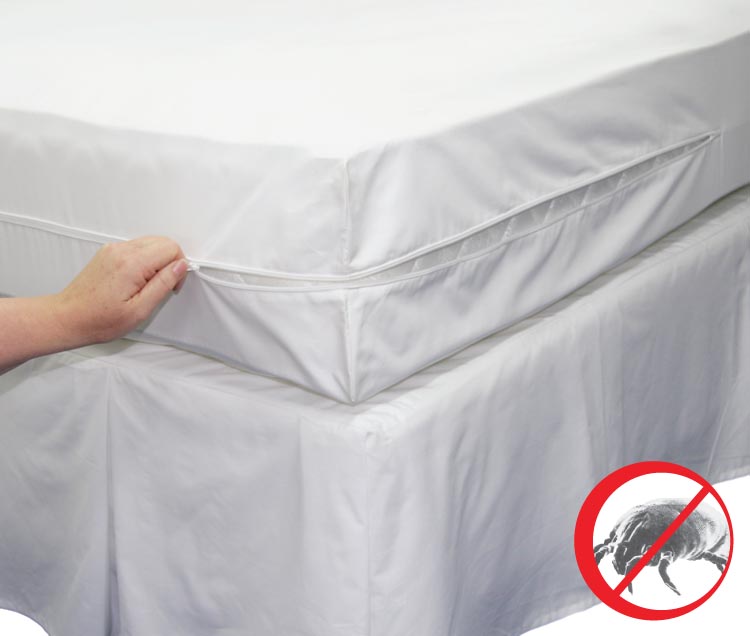FAQ
AllergEnd Plus FAQ and Care Instructions
Q. What is a dust mite cover?
A. Dust mite covers completely encase the mattress, pillow and quilt on all sides to stop dust mites and mite faeces (allergens) from entering or exiting the bedding. The covers zip up and the special fabric blocks mites and allergens. The covers are hot washable as mites may survive cold washing. Dust mite covers are sometimes called encasements or dust mite encasings.

Q. Should normal bed sheets/linen be placed over the AllergEnd Plus covers?
A. Yes, place normal bed sheets and decorative quilt covers over the top of the AllergEnd Plus protective covers on the mattress, pillow and quilt. Wash normal bed linen at least once a week.
Q. Why are my covers so large when new out of the packet?
A. The AllergEnd Plus covers are designed to shrink and as such are manufactured deliberately large to account for this. All the sizes published are after the shrinkage has taken place which mostly occurs after the first hot wash and tumble dry. The great majority of the shrinkage is achieved when tumble dried after washing. Please be aware that the full shrinkage may not always be achieved and a slightly large cover in no way effects the allergen barrier performance or comfort.
Q. Should the covers be washed before fitting the first time?
A. It is a personal preference whether you wash the covers first. Please be sure to measure the mattress, pillow and quilt prior to purchasing to ensure that the covers fit before washing. They cannot be returned or exchanged after washing.
Q. How often do the AllergEnd Plus covers need washing?
A. Our AllergEnd Plus covers need hot washing @ 60 degrees every 8-12 weeks. They can also be tumble dried if required. Tip....Why not add a "Time to Wash AllergEnd Plus Covers" calender reminder for every 8 weeks so its not forgotten! In the case of the EasyCare system the EasyCare fitted sheet should be washed with the quilt and pillow covers every 8-12 week but mattress cover only needs washing every year.
Q. Will the covers soften after washing?
A. Yes after each wash and dry the covers will gradually soften over time.
Q. How long do the AllergEnd Plus covers last?
A. Replacement should be considered after about 10 years or more.
Q. What does the Four Year Warranty cover?
A. Our four-year warranty covers faulty workmanship and materials. This includes fabric faults, zip failures and seams. It does not cover holes created by abuse, undue wear and tear or as a result of the fabric being unduly forced. Please be careful opening the packaging with sharp objects such as scissors or knives.
In the unlikely event of a warranty claim, please contact us for instructions on how to have the product assessed. It is the customer's responsibility (and at the customer's cost) to return the item to us for assessment. We will then make a judgment regarding the validity of the claim and if the item should be replaced or repaired.
-
Encase pillow, mattress and quilt in AllergEnd Plus™ barrier bedding. The great majority of dust mite allergens we are exposed to originate from inside the mattress, pillow and quilt. Click Here to Purchase
-
Wash AllergEnd Plus™ mattress, pillow and quilt covers every 8-12 weeks at 60c to kill house dust mites, remove dust mite allergens and dead skin from the outside of the impervious bedding covers.
-
Tip. Why not add a "Time to Wash AllergEnd Plus Covers" calendar reminder for every 8 weeks so its not forgotten!
-
EasyCare System Washing - Wash the EasyCare fitted sheet every 8-12 weeks at 60c and then only wash the full zip up mattress cover every year. Always place your clean bed sheets over the freshly washed AllergEnd Plus Covers.
-
Warm tumble drying is an option for normal bed sheets and AllergEnd Plus covers. Some may want to tumble dry on every occasion if pollen allergies are an issue. Line drying can gather pollens at certain times of the year.
-
Wash normal bed sheets/linen regularly, at least every week at 60c. Note: Cold washing removes 90% of dust mite allergens as they are water soluble but the dust mite can live through a washing cycle at less than 55c. If the dust mite is not killed in the wash the mite will quickly multiply on the outside of the covers and readily produce more allergens.
-
Sufficiently ventilate the dwelling to decrease humidity. Dust mites need a humid environment to survive. A damp, dark house with lots of soft furnishings will provide ideal conditions for house dust mites to live and breed. Look to make the home, neat, tidy, light and bright.

 Overnight
Overnight
